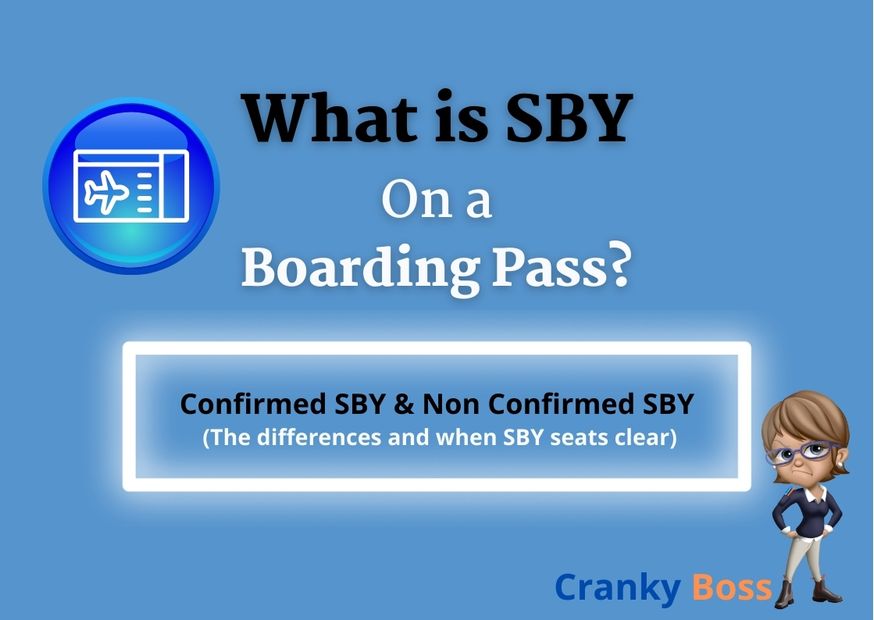If you’ve ever taken a flight and looked at your boarding pass, you might have come across the mysterious letters “SBY” next to your seat assignment. What does “SBY” mean, and why is it there?
“SBY” stands for “Standby.” Standby is a term used in the airline industry to refer to passengers who don’t have a confirmed seat on a particular flight but are hoping to get on board if there are available seats. Essentially, being on standby means you are waiting for a seat to become available on the flight you want to take.

Reasons for Standby
There are a few common reasons why someone might be on standby:
- Missed or Cancelled Flights:
Sometimes, passengers miss their original flights or decide to cancel at the last minute. In such cases, the airline may allow standby passengers to take those empty seats. - Flexible Tickets:
Some travelers purchase flexible or open-ended tickets that allow them to choose a flight on the day of travel. These passengers might be on standby until they find an available flight. - Overbooked Flights:
Airlines often sell more tickets than there are seats available, anticipating that some passengers may not show up. If everyone shows up, the flight becomes overbooked, and some passengers might be asked to go on standby.
How Does Standby Work?
When you are on standby, you usually have to wait at the gate until the boarding process is almost complete. If there are available seats after all the confirmed passengers have boarded, the airline will then call standby passengers to fill those empty seats.
It’s important to note that being on standby doesn’t guarantee you a seat on the flight. If the flight is full or if all the standby seats are taken by other passengers, you may need to wait for the next available flight. You need to be super flexible and patient when dealing with standby seats. It’s not ideal for passengers who may suffer from travel anxiety or families who are travelling with kids.
Standby is also not the same as GTE or being on a waitlist for a ticket to become available.
When will you know if your SBY status has cleared?
Typically when the gate closes. This is about 10-20 minutes on domestic flights and about 30-40 minutes on international flights.
Do you check in your luggage if you are on a standby flight?
Checking in luggage for a standby flight depends on the airline’s policies and your specific situation. Here’s a general guideline:
- If you have a confirmed standby seat:
If the airline has confirmed a standby seat for you before the flight, you can typically check in your luggage as you would for a regular flight. You’ll follow the standard check-in procedures, and your baggage will be loaded onto the plane. - If you are waiting for a standby seat at the airport:
In some cases, you might be on standby without a confirmed seat when you arrive at the airport. In this situation, it’s advisable to check with the airline’s staff at the check-in counter or gate.
If the airline allows you to check in your luggage, they will likely tag it with a standby tag. This means your luggage will only be loaded onto the plane if you are successfully accommodated on the flight. - Carry-on luggage for standby passengers:
Standby passengers are often encouraged to travel with carry-on luggage only. This allows for more flexibility, especially if you end up not getting a seat on the standby flight, and you need to try for a seat on the next available flight.
It’s essential to check the specific policies of the airline you are flying with, as different airlines may have varying procedures for standby passengers. And if you’re getting ready for your trip, don’t forget to take a look at my ultimate travel packing list to make sure you’re all set for your next adventure!
What is a confirmed SBY seat vs a not confirmed SBY seat?
A “confirmed standby seat” and a “not confirmed standby seat” refer to the status of a seat for a passenger who is on standby for a flight.
Confirmed Standby Seat:
A confirmed standby seat means that the airline has successfully allocated a seat for the passenger on a specific flight. This typically occurs when there are available seats due to factors such as no-show passengers, cancellations, or schedule changes.
Passengers with a confirmed standby seat have the assurance that they will be able to board the specified flight.
Not Confirmed Standby Seat:
A not confirmed standby seat, on the other hand, indicates that the passenger is on standby but has not yet been allocated a seat. This could be due to the flight being fully booked or having limited available seats.
Passengers with a not confirmed standby seat are essentially waiting to see if there will be any openings on the flight. Whether or not they get on the plane depends on factors like the number of no-shows, last-minute cancellations, or changes in the flight’s seating availability.
In summary, the key difference lies in whether the airline has been able to secure a seat for the standby passenger. A confirmed standby seat means a seat has been assigned, while a not confirmed standby seat means the passenger is still in the queue, hoping for a seat to become available. Airlines handle standby situations differently, so it’s always advisable for passengers to check with airline staff for specific information and instructions regarding their standby status.
How to Improve Your Chances of Getting off Standby
Here are some ways to improve your chances of getting off standby and onto the flight:
1. Arrive Early & Check In ASAP
Standby lists are often prioritized by check-in time. The earlier you check in, the better your position.
2. Have Elite Status or a Higher Fare Class
Airlines prioritize frequent flyers, premium cabin passengers, and loyalty program members. If you have elite status, you’ll usually be ahead of non-status travelers on the list.
3. Travel Alone
If you’re traveling solo, you’re more likely to get a single open seat compared to a family needing multiple seats.
4. Be Near the Gate & Ready to Board
Standby passengers are called last-minute. If you don’t respond immediately, the seat might go to the next person in line.
5. Choose Less Busy Flights & Off-Peak Times
Flying during non-peak hours (midday or late night) increases your chances of getting a seat since flights tend to be less full.
6. Be Flexible with Your Destination
Some airlines allow standby passengers to reroute through different hubs if a more available flight exists.
7. Politely Check with the Gate Agent
Being friendly and asking nicely if there’s anything that can be done can sometimes work in your favor.
8. Carry On Your Luggage
If you don’t check a bag, the airline might prioritize you because it’s easier to seat passengers who don’t require baggage reloading.
What last minute changes could affect the confirmed SBY seat?
Several last-minute changes and factors could affect a confirmed standby seat, potentially leading to a passenger being denied boarding. Here are some common scenarios:
- Flight Upgrades:
If passengers with higher ticket classes or loyalty status decide to upgrade to the standby class, it could impact the availability of seats. Airlines often prioritize their loyal customers or those who have paid more for premium services.
- Crew Accommodations:
Sometimes, airline crew members may need to be accommodated on a flight at the last minute. If crew members need seats, it could affect the availability of seats for standby passengers.
- Aircraft Changes:
Last-minute aircraft changes due to maintenance issues or other operational reasons might result in a different seating configuration. This can affect the number of available seats in the standby category.
- Overbooking Situations:
If the flight is overbooked and the airline cannot find enough volunteers to give up their seats, standby passengers might be impacted. In such cases, the airline may need to deny boarding to some passengers, including those on standby.
- Late Check-Ins:
Standby passengers who check in late may find that their confirmed seats have been reassigned to passengers who checked in earlier or those who have a SEQ number (another funny abbreviation) that’s low – which means they were one of the first to check in. Airlines often have specific check-in deadlines, and seats may be given to passengers who have complied with these deadlines.
- No-Show Passengers:
While it works in favor of standby passengers in some cases, if passengers with confirmed seats fail to show up, their seats may be released to others, potentially affecting the seating arrangement for standby passengers.
SBY is just one of many codes that may appear on your boarding pass. ‘See Agent’ is another, and it’s exactly that – see an agent before going to the gate.
What’s the Difference Between a Standby Seat and a TBD Seat?
The key difference between SBY (Standby Seat) and TBD (To Be Determined) Seat lies in the passenger’s booking status and how the seat is assigned. If you see SBY on your boarding pass, it means you’re on standby, waiting for an available seat. If you see TBD, it means you have a confirmed ticket, but your exact seat hasn’t been assigned yet. Learn more in our guide on What TBD Means on a Boarding Pass.
💡 Main Difference:
✔ SBY means you’re not guaranteed a seat yet.
✔ TBD means you have a seat, but its exact location is still unassigned.
It’s essential for passengers on standby to be aware of these potential changes and to stay in close communication with airline staff for the latest updates. Standby situations can be dynamic, and factors beyond the passenger’s control may influence the final seating arrangements.

